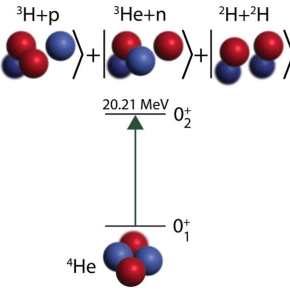- Homepage
- >
- Scientists
- >
- News & Highlights
- >
- 2024
- >
- A change in viewpoint on helium 4 brings nuclear physics out of a dead-end.
A change in viewpoint on helium 4 brings nuclear physics out of a dead-end.
An experimental measurement recently identified a discrepancy between theoretical predictions and the observation of the helium 4 nucleus. The work of an international collaboration of theoreticians elaborated a different vision of the configurations of nucleons and their coupling in helium 4. This evolution in the modeling of the resonant state of this light nucleus allowed to reconcile theory and experiment, bringing scientists closer to understanding major astrophysical phenomena.

Mainz, 2021 : a team of physicists bombards helium 4 nuclei, also known as alpha particle, with a beam of electrons in order to observe the transition from its fundamental state to its first excited state (resonant). This experiment aimed to compare the measurement of a value linked to this transition with its prevision provided by a prominent model of the atomic nucleus, based on effective theories, the “Chiral Effective Field Theories” (ChEFTs). However the value measured at the Microtron of the University of Mainz was two times smaller than the theoretical predictions. Is that a serious setback for certain models of the atomic nucleus ? The hunt was then on : How can a model based on a ChEFT theory explain this experimental observation ?
This puzzle has recently been solved by an international collaboration of theoreticians composed by Nicolas Michel (Chinese Science Academy), Witek Nazarewicz (Michigan State University) and Marek Płoszajczak, physicist at GANIL. Marek explains: “ Using a ChEFT to calculate certain properties of the atomic nucleus first requires to model the behaviour of nucleons inside the nucleus. This is called ‘solving the N-body problem’. Until recently, in order to solve this problem for helium 4, theoreticians considered the alpha particle as an autonomous and independent system inside which nucleons simply move apart from each other when the nucleus absorbs energy. In this configuration, called a closed quantum system, we can imagine the nucleus as a balloon inflating as it receives energy.”
The three physicists then proposed a different vision of the excited nucleus: instead of considering a closed quantum system, the trio of researcher preferred to model the helium 4 as an open system where several reactions channels are juxtaposed (a hydrogen 3 associated with a proton, a helium 3 associated with a neutron or two helium 2 nuclei). “It is precisely the resolution of the N-body problem in the frame of this paradigm that allowed to reproduce the experimental results obtained at MaMi” confirms Marek.
This theoretical gymnastic undoubtedly gives credit to the existing models and can be applied to other light nuclei in order to understand their excitation process. However, this episode highlights the difficulty to take into account the most subtle details in the study of the atomic nuclei and the necessity of such a deep analysis to apprehend even the simplest nuclear phenomena. This path is however worth pursuing as the transitions between ground state and resonant states in light nuclei are particularly important. These transitions, as well as the microscopic structure of the resonant states play a role in astrophysical phenomena such as the formation of neutron stars or the stellar nucleosynthesis. Understanding them brings us a step closer to understanding the global chemistry of the Universe.
Contact: Marek Ploszajczak
Référence: N. Michel, W. Nazarewicz, M. Ploszajczak, Phys. Rev. Lett. 131, 242502 (2023)
